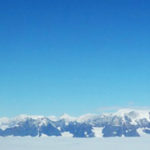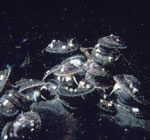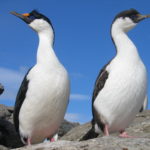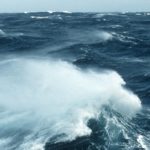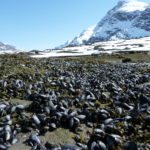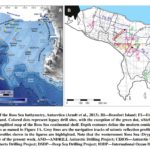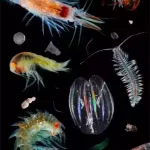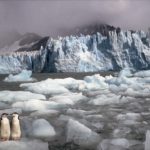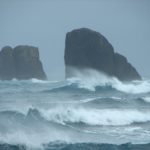Our publications
Showing: All publications
Found 13244 items
Observing the disintegration of the A68A iceberg from space
1 March, 2022 by Laura Gerrish
Icebergs impact the physical and biological properties of the ocean where they drift, depending on the degree of melting. We use satellite imagery and altimetry to quantify the area, thickness,…Read more on Observing the disintegration of the A68A iceberg from space
Polar soils exhibit distinct patterns in microbial diversity and dominant phylotypes
1 March, 2022 by David Pearce
The polar regions, comprising the Antarctic, Arctic and Tibetan Plateau, represent the most extreme environments on Earth. Soils across the polar regions harbor diverse microorganisms, which dominate the biogeochemical cycling.…Read more on Polar soils exhibit distinct patterns in microbial diversity and dominant phylotypes
Sedimentary model for mixed depositional systems along the Pacific margin of the Antarctic Peninsula: decoding the interplay of deep-water processes
1 March, 2022 by Claus-Dieter Hillenbrand, Robert Larter
Mixed (turbidite-contourite) depositional systems are formed by a complex interplay of deep-water processes. An evaluation of their morphological elements and their lateral and spatial distribution is crucial to better understand…Ducted chorus waves cause sub‐relativistic and relativistic electron microbursts
1 March, 2022 by Richard Horne
During magnetospheric storms, radiation belt electrons are produced and then removed by collisions with the lower atmosphere on varying timescales. An efficient loss process is microbursts, strong, transient precipitation of…Read more on Ducted chorus waves cause sub‐relativistic and relativistic electron microbursts
Mesosphere and lower thermosphere winds and tidal variations during the 2019 Antarctic Sudden Stratospheric Warming
1 March, 2022 by Tracy Moffat-Griffin
Realistic modeling of the winds and dynamical variations in the mesosphere and lower thermosphere (MLT) at Southern Hemisphere (SH) mid-to-high latitudes near 60oS where dramatic motions occur has been a…An extreme high temperature event in coastal East Antarctica associated with an atmospheric river and record summer downslope winds
28 February, 2022 by Hua Lu, John King, John Turner, Tony Phillips
High surface temperatures are important in Antarctica because of their role in ice melt and sea level rise. We investigate a high temperature event in December 1989 that gave record…Basal melting, roughness and structural integrity of ice shelves
28 February, 2022 by Robert Larter
Ice shelves restrict outflow from many of the largest glaciers in Antarctica, thus limiting the Antarctic contribution to sea-level rise. However, past ice-shelf collapse events show they are highly vulnerable…Read more on Basal melting, roughness and structural integrity of ice shelves
Sensitivity of melting, freezing and marine ice beneath Larsen C Ice Shelf to changes in ocean forcing
28 February, 2022 by Alex Brisbourne, Keith Nicholls, Lianne Harrison, Paul Holland
Observations of surface lowering on Larsen C Ice Shelf (LCIS), Antarctica, have prompted concern about its stability. In this study, an ocean model is used to investigate the extent to…Using metabarcoding to assess Viridiplantae sequence diversity present in Antarctic glacial ice
28 February, 2022 by Peter Convey
Antarctica contains most of the glacial ice on the planet, a habitat that is largely unexplored by biologists. Recent warming in parts of Antarctica, particularly the Antarctic Peninsula region, is…Sensitivity of the West Antarctic Ice Sheet to +2 °C (SWAIS 2C)
25 February, 2022 by James Smith, Louise Sime
The West Antarctic Ice Sheet (WAIS) presently holds enough ice to raise global sea level by 4.3 m if completely melted. The unknown response of the WAIS to future warming remains…Read more on Sensitivity of the West Antarctic Ice Sheet to +2 °C (SWAIS 2C)
Brief communication: Impact of common ice mask in surface mass balance estimates over the Antarctic ice sheet
25 February, 2022 by Andrew Orr
Regional climate models compute ice sheet surface mass balance (SMB) over a mask that defines the area covered by glacier ice, but ice masks have not been harmonised between models.…Under-ice light field analysis in the western Arctic Ocean during late summer
23 February, 2022 by Gaelle Veyssiere, Jeremy Wilkinson
The Arctic is no longer a region dominated by thick multi-year ice (MYI), but by thinner, more dynamic, first-year-ice (FYI). This shift towards a seasonal ice cover has consequences for…Read more on Under-ice light field analysis in the western Arctic Ocean during late summer
Deep water inflow slowed offshore expansion of the West Antarctic Ice Sheet at the Eocene-Oligocene transition
21 February, 2022 by Claus-Dieter Hillenbrand, Robert Larter
The stability of the West Antarctic Ice Sheet is threatened by the incursion of warm Circumpolar Deepwater which flows southwards via cross-shelf troughs towards the coast there melting ice shelves.…Subglacial water flow over an Antarctic palaeo-ice stream bed
18 February, 2022 by James Kirkham, Kelly Hogan, Robert Larter
The subglacial hydrological system exerts a critical control on the dynamic behaviour of the overlying ice because its configuration affects the degree of basal lubrication between the ice and the…Read more on Subglacial water flow over an Antarctic palaeo-ice stream bed
Geomagnetically induced current model in New Zealand across multiple disturbances: Validation and extension to non‐monitored transformers
18 February, 2022 by Mark Clilverd
Geomagnetically induced currents (GICs) produced during geomagnetic disturbances pose a risk to the safe operation of electrical power networks. One route to determine the hazard of large and extreme geomagnetic…Benthic biodiversity, carbon storage and the potential for increasing negative feedbacks on climate change in shallow waters of the Antarctic Peninsula
17 February, 2022 by Belinda Vause, David Barnes, Terri Souster, Laura Gerrish, Lloyd Peck, Simon Morley, Terri Souster
Seafloor biodiversity provides a key ecosystem service, as an efficient route for carbon to be removed from the atmosphere to become buried (long-term) in marine sediment. Protecting near intact ecosystems,…The extremes of disturbance reduce functional redundancy: Functional trait assessment of the shallow Antarctic benthos
17 February, 2022 by Ben Robinson, David Barnes, Simon Morley
Climate-driven changes in disturbance are a major threat to ecosystem Functional diversity. The selective mechanisms underlying ecosystem response to disturbance are far from universal and remain the subject of scientific…Sea ice concentration impacts dissolved organic gases in the Canadian Arctic
17 February, 2022 by Anna Jones
The marginal sea ice zone has been identified as a source of different climate-active gases to the atmosphere due to its unique biogeochemistry. However, it remains highly undersampled, and the…Read more on Sea ice concentration impacts dissolved organic gases in the Canadian Arctic
Monitoring space weather: using automated, accurate neural network based whistler segmentation for whistler inversion
16 February, 2022 by Mark Clilverd
It is challenging, yet important, to measure the - ever-changing - cold electron density in the plasmasphere. The cold electron density inside and outside of the plasmapause is a key…Ice core chronologies from the Antarctic Peninsula: The Palmer, Jurassic, and Rendezvous age-scales
16 February, 2022 by Diana Vladimirova, Dieter Tetzner, Jack Humby, Liz Thomas
In this study, we present the age scales for three Antarctic Peninsula (AP) ice cores: Palmer, Rendezvous, and Jurassic. The three cores are all intermediate-depth cores, in the 133–141 m…Latitude, elevation, and mean annual temperature predict peat organic matter chemistry at a global scale
13 February, 2022 by Dominic Hodgson, Peter Convey
Peatlands contain a significant fraction of global soil carbon, but how these reservoirs will respond to the changing climate is still relatively unknown. A global picture of the variations in…The role of allochrony in influencing interspecific differences in foraging distribution during the non-breeding season between two congeneric crested penguin species
9 February, 2022 by Norman Ratcliffe
Mechanisms promoting coexistence between closely related species are fundamental for maintaining species diversity. Mechanisms of niche differentiation include allochrony which offsets the peak timing of resource utilisation between species. Many…Aerial detection of beached marine plastic using a novel, hyperspectral short-wave infrared (SWIR) camera
8 February, 2022 by Claire Waluda
Plastic pollution in the marine environment is a pervasive, global problem that threatens wildlife and human health. Routine monitoring is required to determine pollution hotspots, focus clean-up efforts, and assess…Overview of the MOSAiC expedition: Snow and sea ice
7 February, 2022 by Markus Frey
Year-round observations of the physical snow and ice properties and processes that govern the ice pack evolution and its interaction with the atmosphere and the ocean were conducted during the…Read more on Overview of the MOSAiC expedition: Snow and sea ice
Overview of the MOSAiC expedition – Atmosphere
7 February, 2022 by Amelie Kirchgaessner, Markus Frey
With the Arctic rapidly changing, the needs to observe, understand, and model the changes are essential. To support these needs, an annual cycle of observations of atmospheric properties, processes, and…Vegetation interactions with geotechnical properties and erodibility of salt marsh sediments
5 February, 2022 by Ben Evans
Salt marshes provide diverse ecosystem services including coastal protection, habitat provision and carbon sequestration. The loss of salt marshes is a global scale phenomenon, of great socio-economic concern due to…Belgica antarctica (Diptera: Chironomidae): A natural model organism for extreme environments
1 February, 2022 by Peter Convey
Belgica antarctica (Diptera: Chironomidae), a brachypterous midge endemic to the maritime Antarctic, was first described in 1900. Over more than a century of study, a vast amount of information has…Continuous flow analysis methods for sodium, magnesium and calcium detection in the Skytrain ice core
1 February, 2022 by Jack Humby, Julius Rix, Liz Thomas, Rebecca Tuckwell, Robert Mulvaney
Dissolved and particulate sodium, magnesium and calcium are analyzed in ice cores to determine past changes in sea ice extent, terrestrial dust variability and atmospheric aerosol transport efficiency. They are…Evolutionary constraints on physiology confound range shift predictions of two nacellid limpets
1 February, 2022 by Laura Gerrish, Simon Morley
Physiological comparisons are fundamental to quantitative assessments of the capacity of species to persist within their current distribution and to predict their rates of redistribution in response to climate change.…Biogeochemical consequences of a changing Arctic shelf seafloor ecosystem
1 February, 2022 by David Barnes, Terri Souster, Terri Souster
Unprecedented and dramatic transformations are occurring in the Arctic in response to climate change, but academic, public, and political discourse has disproportionately focussed on the most visible and direct aspects…Read more on Biogeochemical consequences of a changing Arctic shelf seafloor ecosystem
Temperature impact on the influence of penguin-derived nutrients and mosses on non-native grass in a simulated polar ecosystem
1 February, 2022 by Peter Convey
Human activity and climate change are increasing the spread of species across the planet, threatening biodiversity and ecosystem functions. Invasion engineers, such as birds, facilitate plant growth through manuring of…Cold comfort: Arctic seabirds find refugia from climate change and potential competition in marginal ice zones and fjords
1 February, 2022 by Anne-Sophie Bonnet-Lebrun, Derren Fox, Norman Ratcliffe, Tim Morley
Climate change alters species distributions by shifting their fundamental niche in space through time. Such effects may be exacerbated by increased inter-specific competition if climate alters species dominance where competitor…The Time Machine framework: monitoring and prediction of biodiversity loss
1 February, 2022 by Scott Hosking
Transdisciplinary solutions are needed to achieve the sustainability of ecosystem services for future generations. We propose a framework to identify the causes of ecosystem function loss and to forecast the…Read more on The Time Machine framework: monitoring and prediction of biodiversity loss
Long-term population size and trends of South Georgia Shags (Leucocarbo [atriceps] georgianus) at Signy Island, South Orkney Islands and Bird Island, South Georgia
1 February, 2022 by Derren Fox, Jennifer Jackson, Michael Dunn, Stacey Adlard
The South Georgia Shag Leucocarbo [atriceps] georgianus has breeding populations on the islands of South Georgia, the South Sandwich and South Orkney Islands. The South Orkney Islands are estimated to…Shine a light: Under-ice light and its ecological implications in a changing Arctic Ocean
1 February, 2022 by Gaelle Veyssiere
The Arctic marine ecosystem is shaped by the seasonality of the solar cycle, spanning from 24-h light at the sea surface in summer to 24-h darkness in winter. The amount…Can a key boreal Calanus copepod species now complete its life-cycle in the Arctic? Evidence and implications for Arctic food-webs
1 February, 2022 by Anna Belcher, Geraint Tarling, Gabriele Stowasser, Jennifer Freer
The changing Arctic environment is affecting zooplankton that support its abundant wildlife. We examined how these changes are influencing a key zooplankton species, Calanus finmarchicus, principally found in the North…Colonization of the Southern Hemisphere by Sagina and Colobanthus (Caryophyllaceae)
1 February, 2022 by Elisabeth Biersma
Colobanthus (23 species) and Sagina (30–33 species) together are sister to Facchinia. Whereas Facchinia is distributed in western Eurasia, Colobanthus is almost exclusively distributed in the Southern Hemisphere, and Sagina…Read more on Colonization of the Southern Hemisphere by Sagina and Colobanthus (Caryophyllaceae)
Stepping stones towards Antarctica: Switch to southern spawning grounds explains an abrupt range shift in krill
1 February, 2022 by Geraint Tarling, Simeon Hill
Poleward range shifts are a global-scale response to warming, but these vary greatly among taxa and are hard to predict for individual species, localized regions or over shorter (years to…Commercial fishery disturbance of the global ocean biological carbon sink
1 February, 2022 by Simeon Hill
Plankton drive a major sink of carbon across the global oceans. Dead plankton, their faeces and the faeces of plankton feeders, form a huge rain of carbon sinking to the…Read more on Commercial fishery disturbance of the global ocean biological carbon sink
Chemical compounds and antioxidant activity of Antarctic lichens
1 February, 2022 by Peter Convey
We assessed the content of some major and trace elements and lichen compounds as well as antioxidant activity in eight lichen species representing four families collected in areas > 1…Read more on Chemical compounds and antioxidant activity of Antarctic lichens
Acceleration of electrons by whistler-mode hiss waves at Saturn
1 February, 2022 by Andrew Kavanagh, Emma Woodfield, Richard Horne, Sarah Glauert
Plasmaspheric hiss waves at the Earth are well known for causing losses of electrons from the radiation belts through wave particle interactions. At Saturn, however, we show that the different…Read more on Acceleration of electrons by whistler-mode hiss waves at Saturn
RAS Specialist Discussion Meeting report
1 February, 2022 by Rob Shore
Report on the RAS Specialist Discussion Meeting ‘System-scale observations and modelling of solar wind-magnetosphere-ionosphere-thermosphere (SW-M-I-T) coupling’.Music of the spheres
1 February, 2022 by Amanda Wynne, Nigel Meredith
The Sounds of Space Project harvests found sounds and signals from Earth and way beyond, and gathers them into evocative sonic compositions.Distributions of Birkeland current density observed by AMPERE are heavy‐tailed or long‐tailed
1 February, 2022 by Gareth Chisham, Mervyn Freeman
We analyze probability distributions of Birkeland current densities measured by the Active Magnetosphere and Planetary Electrodynamics Response Experiment (AMPERE). We find that the distributions are leptokurtic rather than normal and…Sustaining Arctic Observing Networks’ (SAON) Roadmap for Arctic Observing and Data Systems (ROADS)
1 February, 2022 by Jeremy Wilkinson
Arctic observing and data systems have been widely recognized as critical infrastructures to support decision making and understanding across sectors in the Arctic and globally. Yet due to broad and…The Whole Antarctic Ocean Model (WAOM v1.0): Development and evaluation
26 January, 2022 by Kaitlin Naughten
The Regional Ocean Modeling System (ROMS), including an ice shelf component, has been applied on a circum-Antarctic domain to derive estimates of ice shelf basal melting. Significant improvements made compared…Read more on The Whole Antarctic Ocean Model (WAOM v1.0): Development and evaluation
Large mesopelagic fish biomass in the Southern Ocean resolved by acoustic properties
26 January, 2022 by Tracey Dornan, Ryan Saunders, Sophie Fielding, Tracey Dornan, Tracey Dornan
The oceanic mesopelagic zone, 200–1000 m below sea level, holds abundant small fishes that play central roles in ecosystem function. Global mesopelagic fish biomass estimates are increasingly derived using active…Read more on Large mesopelagic fish biomass in the Southern Ocean resolved by acoustic properties
Reconstructing Antarctic winter sea-ice extent during Marine Isotope Stage 5e
24 January, 2022 by Claire Allen, Claus-Dieter Hillenbrand, Louise Sime, Matthew Chadwick
Environmental conditions during Marine Isotope Stage (MIS) 5e (130–116 ka) represent an important “process analogue” for understanding the climatic responses to present and future anthropogenic warming. The response of Antarctic sea…Read more on Reconstructing Antarctic winter sea-ice extent during Marine Isotope Stage 5e
Airborne quantification of net methane and carbon dioxide fluxes from European Arctic wetlands in Summer 2019
24 January, 2022 by James France
Arctic wetlands and surrounding ecosystems are both a significant source of methane (CH4) and a sink of carbon dioxide (CO2) during summer months. However, precise quantification of this regional CH4…Isotopic signatures of methane emissions from tropical fires, agriculture and wetlands: the MOYA and ZWAMPS flights
24 January, 2022 by Anna Jones, James France
We report methane isotopologue data from aircraft and ground measurements in Africa and South America. Aircraft campaigns sampled strong methane fluxes over tropical papyrus wetlands in the Nile, Congo and…Rising methane: is there a methane emergency? [Preface]
24 January, 2022 by Anna Jones
These two volumes of the Royal Society's Philosophical Transactions record the ‘state of methane’ in 2021. The atmospheric methane burden rose rapidly in 2020: more rapidly than at any previous…Read more on Rising methane: is there a methane emergency? [Preface]
Is the destruction or removal of atmospheric methane a worthwhile option?
24 January, 2022 by James France
Removing methane from the air is possible, but do the costs outweigh the benefits? This note explores the question of whether removing methane from the atmosphere is justifiable. Destruction of…Read more on Is the destruction or removal of atmospheric methane a worthwhile option?
δ13C methane source signatures from tropical wetlands and rice field emissions
24 January, 2022 by Anna Jones, James France
The atmospheric methane (CH4) burden is rising sharply, but the causes are still not well understood. One factor of uncertainty is the importance of tropical CH4 emissions into the global…Read more on δ13C methane source signatures from tropical wetlands and rice field emissions
Sea-level rise: From global perspectives to local services
20 January, 2022 by Paul Holland
Coastal areas are highly diverse, ecologically rich, regions of key socio-economic activity, and are particularly sensitive to sea-level change. Over most of the 20th century, global mean sea level has…Read more on Sea-level rise: From global perspectives to local services
Strong and widespread cycloheximide resistance in Stichococcus-like eukaryotic algal taxa
20 January, 2022 by Peter Convey
This study was initiated following the serendipitous discovery of a unialgal culture of a Stichococcus-like green alga (Chlorophyta) newly isolated from soil collected on Signy Island (maritime Antarctica) in growth…Ship traffic connects Antarctica’s fragile coasts to worldwide ecosystems
18 January, 2022 by Arlie McCarthy, Lloyd Peck
Antarctica, an isolated and long considered pristine wilderness, is becoming increasingly exposed to the negative effects of ship-borne human activity, and especially the introduction of invasive species. Here, we provide…Read more on Ship traffic connects Antarctica’s fragile coasts to worldwide ecosystems
Variation among species and populations in bill shape and size in three planktivorous petrels
18 January, 2022 by Richard Phillips
Morphological variation in biological structures may be driven by genetic and environmental factors, such as inter- and intraspecific competition for resources. In seabirds, although the bill is also involved in…Molecular responses to thermal and osmotic stress in Arctic intertidal mussels (Mytilus edulis): The limits of resilience
15 January, 2022 by Lloyd Peck, Melody Clark, Nicholas Barrett
Increases in Arctic temperatures have accelerated melting of the Greenland icesheet, exposing intertidal organisms, such as the blue mussel Mytilus edulis, to high air temperatures and low salinities in summer.…Ice front retreat reconfigures meltwater-driven gyres modulating ocean heat delivery to an Antarctic ice shelf
13 January, 2022 by Alexander Bradley, Pierre Dutrieux, Robert Larter
Pine Island Ice Shelf (PIIS) buttresses the Pine Island Glacier, the key contributor to sea-level rise. PIIS has thinned owing to ocean-driven melting, and its calving front has retreated, leading…Landfast ice controls on turbulence in Antarctic coastal seas
11 January, 2022 by Alexander Brearley
Knowledge of the ocean surface layer beneath Antarctic landfast ice is sparse. In this article surface layer turbulent and fine structure are quantified with and without landfast ice in the…Read more on Landfast ice controls on turbulence in Antarctic coastal seas
Cosmogenic radionuclides reveal an extreme solar particle storm near a solar minimum 9125 years BP
11 January, 2022 by Florian Mekhaldi
During solar storms, the Sun expels large amounts of energetic particles (SEP) that can react with the Earth’s atmospheric constituents and produce cosmogenic radionuclides such as 14C, 10Be and 36Cl.…Parker Ice Tongue collapse, Antarctica, triggered by loss of stabilizing land-fast sea ice
10 January, 2022 by Oliver Marsh
After a likely multi-century period of intermittent calving, the full length of Parker Ice Tongue (18 km or 41 km2), calved in March 2020 co-incident with repeated summer break-outs of…Radar derived subglacial properties and landforms beneath Rutford Ice Stream, West Antarctica
7 January, 2022 by Alex Brisbourne, Andy Smith, Ed King
Basal properties beneath ice streams and glaciers are known to be a control for ice flow dynamics, hence knowledge of them is crucial for predicting sea level due to changes…Examination of radiation belt dynamics during substorm clusters: Activity drivers and dependencies of trapped flux enhancements
6 January, 2022 by Mark Clilverd
Dynamical variations of radiation belt trapped electron fluxes are examined to better understand the variability of enhancements linked to substorm clusters. Analysis is undertaken using the Substorm Onsets and Phases…Ultramafic mantle xenoliths in the Late Cenozoic Volcanic rocks of the Antarctic Peninsula and Jones Mountains, West Antarctica
1 January, 2022 by Philip Leat
Abundant mantle-derived ultramafic xenoliths occur in Cenozoic (7.7-1.5 Ma) mafic alkaline volcanic rocks along the former active margin of West Antarctica, that extends from the northern Antarctic Peninsula to Jones…Intra-specific variation in lichen secondary compounds across environmental gradients on Signy Island, maritime Antarctic
1 January, 2022 by Peter Convey
Lichens produce various carbon-based secondary compounds (CBSCs) in response to abiotic conditions and herbivory. Although lichen CBSCs have received considerable attention with regard to responses to UV-B exposure, very little…Early and middle Miocene ice sheet dynamics in the Ross Sea: Results from integrated core-log-seismic interpretation
1 January, 2022 by Lara Perez Miguel, Robert Larter
Oscillations in ice sheet extent during early and middle Miocene are intermittently preserved in the sedimentary record from the Antarctic continental shelf, with widespread erosion occurring during major ice sheet…Biosynthetic potential of uncultured Antarctic soil bacteria revealed through long-read metagenomic sequencing
1 January, 2022 by Kevin Newsham
The growing problem of antibiotic resistance has led to the exploration of uncultured bacteria as potential sources of new antimicrobials. PCR amplicon analyses and short-read sequencing studies of samples from…The ecosystem approach to management of the Antarctic krill fishery – the ‘devils are in the detail’ at small spatial and temporal scales
1 January, 2022 by Emma Young, Philip Trathan, Victoria Warwick-Evans
Fishery demand for Antarctic krill is increasing, and projected to continue increasing into the future. Krill has the potential to contribute approximately 10% to all future marine landings, adding significantly…Small-scale spatial-temporal variability in snow cover and relationships with vegetation and climate in maritime Antarctica
1 January, 2022 by Roger Worland, Peter Convey
Snow cover changes can have important effects on ecosystems, especially where spatial variability in cover is high, influencing the biogeochemical conditions of the underlying soil as well as the vegetation.…Modelling the biogeographic boundary shift of Calanus finmarchicus reveals drivers of Arctic Atlantification by subarctic zooplankton
1 January, 2022 by Geraint Tarling, Jennifer Freer
Biological communities in the Arctic are changing through the climate-driven encroachment of subarctic species. This ‘Atlantification’ extends to keystone Calanoid copepods, as the small-bodied Calanus finmarchicus increases in abundance in…Ventilation of the Southern Ocean pycnocline
1 January, 2022 by Dani Jones
Ocean ventilation is the transfer of tracers and young water from the surface down into the ocean interior. The tracers that can be transported to depth include anthropogenic heat and…Quantification of blue carbon pathways contributing to negative feedback on climate change following glacier retreat in West Antarctic fjords
1 January, 2022 by Chester Sands, David Barnes, Nadescha Zwerschke
Global warming is causing significant losses of marine ice around the polar regions. In Antarctica, the retreat of tidewater glaciers is opening up novel, low-energy habitats (fjords) that have the…Methane emissions in Kuwait: Plume identification, isotopic characterisation and inventory verification
1 January, 2022 by James France
The distribution of methane sources in Kuwait was mapped through mobile vehicle surveying of methane mole fraction, and by collection of air samples at source for subsequent isotopic analysis. Mobile…Green algae (Viridiplantae) in sediments from three lakes on Vega Island, Antarctica, assessed using metabarcoding
1 January, 2022 by Peter Convey
Vega Island is located off the eastern tip of the Antarctic Peninsula (Maritime Antarctica), in the Weddell Sea. In this study, we used metabarcoding to investigate green algal DNA sequence…Low‐salinity transitions drive abrupt microbial response to sea‐level change
1 January, 2022 by Alexander Whittle
The salinisation of many coastal ecosystems is underway and is expected to continue into the future because of sea-level rise and storm intensification brought about by the changing climate. However,…Read more on Low‐salinity transitions drive abrupt microbial response to sea‐level change
How does the Southern Ocean palaeoenvironment during Marine Isotope Stage 5e compare to the modern?
1 January, 2022 by Claire Allen, Claus-Dieter Hillenbrand, Louise Sime, Matthew Chadwick
Marine Isotope Stage (MIS) 5e (130–116 ka) represents an important ‘process analogue’ for understanding the climatic feedbacks and responses likely active under future anthropogenic warming. Reconstructing the Southern Ocean (SO) palaeoenvironment…Environmental harshness mediates the relationship between aboveground and belowground communities in Antarctica
1 January, 2022 by Peter Convey
Linkages between aboveground and belowground communities are a key but globally under-researched component of responses to environmental change. Given the logistical complications to studying these relationships, much of our knowledge…Kinetic energy transfers between mesoscale and submesoscale motions in the open ocean’s upper layers
1 January, 2022 by Christian Buckingham
Mesoscale eddies contain the bulk of the ocean’s kinetic energy (KE), but fundamental questions remain on the cross-scale KE transfers linking eddy generation and dissipation. The role of submesoscale flows…Antarctic krill likely avoid underwater gliders
1 January, 2022 by Alexander Brearley, Sophie Fielding
The extent to which marine species avoid survey vessels is the subject of considerable debate, with stimuli such as noise and pressure waves receiving particular attention. By some estimates, avoidance…Read more on Antarctic krill likely avoid underwater gliders
HEPPA III intercomparison experiment on electron precipitation impacts, part I: Estimated ionization rates during a geomagnetic active period in April 2010
1 January, 2022 by Mark Clilverd
Precipitating auroral and radiation belt electrons are considered an important part of the natural forcing of the climate system. Recent studies suggest that this forcing is underestimated in current chemistry-climate…Under pressure: Nanoplastics as a further stressor for sub-Antarctic pteropods already tackling ocean acidification [Short communication]
1 January, 2022 by Clara Manno, Elisa Bergami, Victoria Peck
In the Southern Ocean (SO), plastic debris has already been found in waters and sediments. Nanoplastics (A horizon scan of global biological conservation issues for 2022
1 January, 2022 by Lloyd Peck
We present the results of our 13th annual horizon scan of issues likely to impact on biodiversity conservation. Issues are either novel within the biological conservation sector or could cause…Read more on A horizon scan of global biological conservation issues for 2022
Independent evolution of intermediate bill widths in a seabird clade
1 January, 2022 by Richard Phillips
Interspecific introgression can occur between species that evolve rapidly within an adaptive radiation. Pachyptila petrels differ in bill size and are characterised by incomplete reproductive isolation, leading to interspecific gene…Read more on Independent evolution of intermediate bill widths in a seabird clade
Convolutional conditional neural processes for local climate downscaling
1 January, 2022 by Scott Hosking
A new model is presented for multisite statistical downscaling of temperature and precipitation using convolutional conditional neural processes (convCNPs). ConvCNPs are a recently developed class of models that allow deep-learning…Read more on Convolutional conditional neural processes for local climate downscaling
Blue Carbon Sinks on Polar Seabeds and Their Feedbacks on Climate Change
1 January, 2022 by David Barnes
Blue carbon held in polar organisms has been little considered in terms of global carbon sinks and impacts on climate change. Although the magnitude of sinks is small compared with…Read more on Blue Carbon Sinks on Polar Seabeds and Their Feedbacks on Climate Change
Street-level methane emissions of Bucharest, Romania and the dominance of urban wastewater
1 January, 2022 by James France
Atmospheric methane (CH4) continues to increase, but there are multiple anthropogenic source categories that can be targeted for cost-effective emissions reduction. Cities emit CH4 to the atmosphere from a mixture…Seed fungal endophytes promote the establishment of invasive Poa annua in Maritime Antarctica
1 January, 2022 by Kevin Newsham
Background Invasive plants may displace native species. This is the case of Poa annua, the only non-native plant species successfully established in Maritime Antarctica. Nonetheless, it is uncertain which factors…Antarctic Hairgrass Rhizosphere Microbiomes: Microscale Effects Shape Diversity, Structure, and Function
1 January, 2022 by Peter Convey
The rhizosphere microbiome of the native Antarctic hairgrass Deschampsia antarctica from the central maritime Antarctic was investigated using 16S RNA metagenomics and compared to those of the second native Antarctic…Modelos de Distribución de Especie de Telmatogeton magellanicus (Diptera: Chironomidae) como herramienta para detectar los avances del cambio climático en la Reserva de Biosfera de Cabo de Hornos, ecorregión subantártica de Magallanes
1 January, 2022 by Felipe Simoes, Peter Convey
Los impactos del cambio climático están afectando fuertemente los ecosistemas, comunidades y especies terrestres y acuáticas de las regiones polares y subpolares. La ecorregión subantártica de Magallanes, debido a sus…Genetic variation in a small bivalve along a retreating glacier fjord, King George Island, Antarctica
31 December, 2021 by Chester Sands, David Barnes
Climate change is strongly influencing regions of Antarctica but the consequences on microevolutionary processes have been little studied. Patterns of population genetic diversity were analysed in the Antarctic bivalve Nuculana…Early-winter North Atlantic low-level jet latitude biases in climate models: Implications for simulated regional atmosphere-ocean linkages
30 December, 2021 by Hua Lu, Thomas Bracegirdle
Climate model biases in the North Atlantic (NA) low-level tropospheric westerly jet are a major impediment to reliably representing variability of the NA climate system and its wider influence, in…Interpopulational differences in the nutritional condition of Aequiyoldia eightsii (Protobranchia: Nuculanidae) during austral summer at the Western Antarctic Peninsula
21 December, 2021 by Hugh Venables, Michael Meredith, Simon Morley
The Western Antarctic Peninsula (WAP) is a hotspot for environmental change and has a strong environmental gradient from North to South. Here, for the first time we used adult individuals…